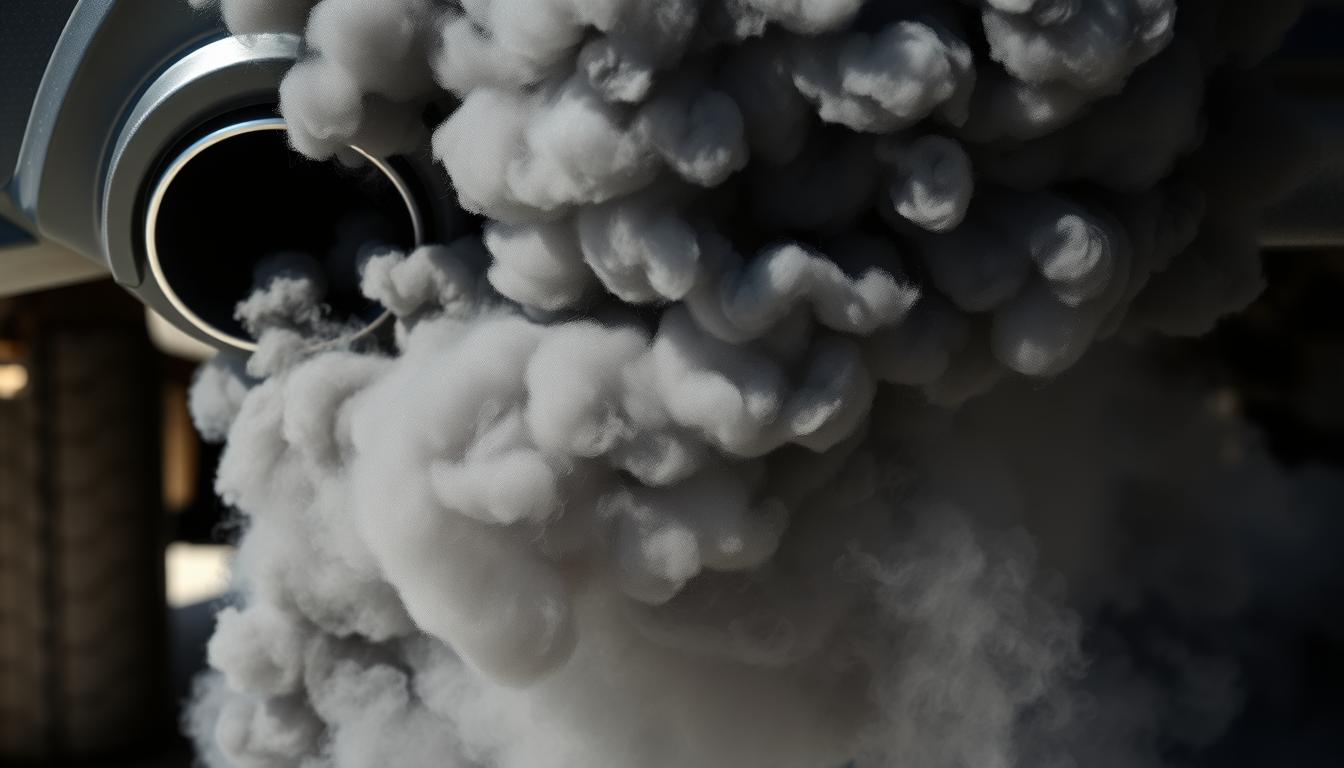Seeing your vehicle emitting smoke from the exhaust can be scary. It’s a common problem many Toyota owners deal with. It usually means there’s an issue that needs fixing.
Smoke coming from your car’s exhaust pipe is worrying. Knowing why it happens is key to fixing it. It could be a small issue or something bigger, but finding the cause is the first step.
Fixing it quickly can stop more damage to your car. In the next parts, we’ll look at why exhaust smoke happens. We’ll also talk about how to make your Toyota run well again.
Understanding Exhaust Smoke Symptoms
The color and consistency of your Toyota’s exhaust smoke can tell you a lot. It’s important to know what it means to catch problems early.
Why Exhaust Smoke Indicates Problems
Exhaust smoke is not just a bother; it often points to a bigger issue. If your Toyota is smoking, it might have engine problems, cooling system issues, or other mechanical faults. Knowing the color and type of smoke helps figure out the problem.
Normal vs. Problematic Exhaust Emissions
Not all exhaust emissions are bad. But, some types of smoke can mean serious trouble. For example:
- White smoke might mean coolant is leaking into the engine.
- Blue or gray smoke could show oil is being burned up because of worn parts.
- Black smoke often means the fuel mix is too rich or the air filter is clogged.
Knowing these differences is key for Toyota exhaust smoke troubleshooting. It helps find and fix the real problem.
By watching the color and type of smoke from your Toyota, you can start fixing issues. This keeps your vehicle running well.
Types of Exhaust Smoke in Toyota Vehicles
The color of exhaust smoke from your Toyota can tell you a lot. It’s not just a problem; it’s a clue to what’s wrong with your car. It can point to issues in the engine or other parts.
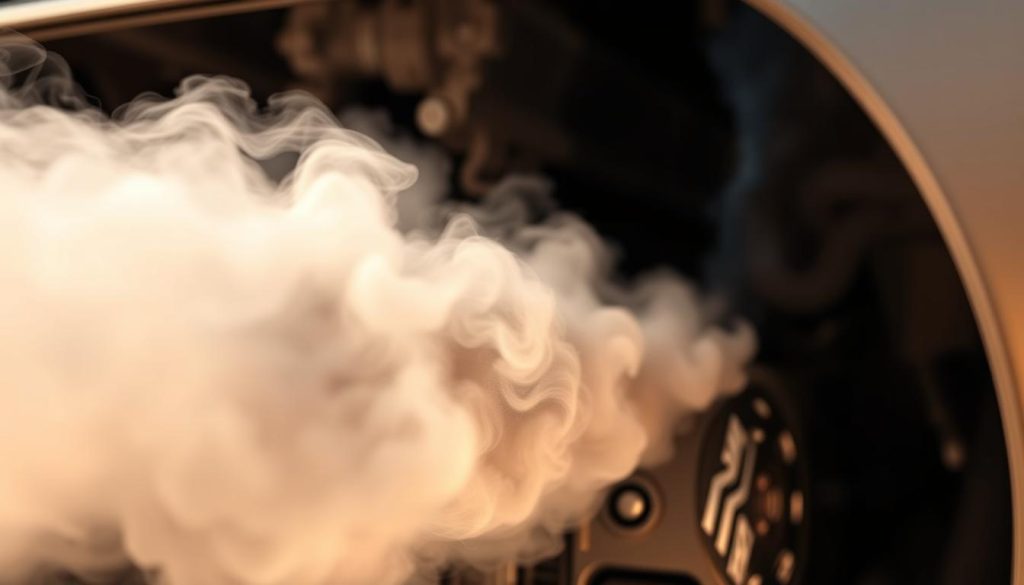
White/Gray Smoke Characteristics
White or gray smoke means coolant is leaking into the engine. This could be because of a cracked engine block or a blown head gasket. If you see white smoke, it smells sweet, you need to fix it fast to protect your engine.
Blue/Gray Smoke Indicators
Blue or blue-gray smoke means engine oil is being burned with fuel. This might be because of worn valve seals or damaged piston rings. You’ll often see this smoke when starting up or speeding up.
Black Smoke Symptoms
Black smoke means there’s too much fuel in the engine. It could be because of a clogged air filter or faulty fuel injectors. Black smoke wastes fuel and can harm the catalytic converter and other parts.
Knowing about these smoke colors helps you find and fix problems with your Toyota. By watching the smoke color, you can fix your car early and avoid bigger issues. For help on how to fix smoking exhaust Toyota problems, see a professional mechanic or a Toyota dealer.
Common Causes of White Smoke from Toyota Exhaust
White smoke from a Toyota’s exhaust can signal serious issues. These problems often involve the engine or cooling system.
Coolant Leaking into Combustion Chamber
White smoke is often due to coolant leaking into the engine. This can be caused by a cracked engine block or a bad head gasket. When this happens, the coolant gets burned with fuel, creating white smoke.
Cracked Cylinder Head or Engine Block
A cracked cylinder head or engine block can also cause white smoke. Coolant leaks into the engine, getting burned and producing smoke. This is a major problem that needs quick fixing to avoid more damage.
Blown Head Gasket Symptoms
A blown head gasket is another reason for white smoke. Signs include white smoke, overheating, and coolant loss. Replacing the head gasket is key to avoiding engine failure.
Figuring out why there’s white smoke is important for fixing it right. If you’re not sure, it’s best to get a professional mechanic’s help.
Reasons for Blue Smoke in Toyota Engines
Blue smoke from a Toyota vehicle means the engine is burning oil. This can lead to bigger problems if not fixed. It usually happens when engine parts wear out or get damaged.
Worn Valve Seals and Guides
Worn valve seals and guides cause blue smoke in Toyota engines. They can break down over time, letting oil into the combustion chamber. This oil gets burned, causing blue smoke. Regular checks can spot worn valve seals before they cause big problems.
Damaged Piston Rings
Damaged or worn piston rings also cause blue smoke. These rings keep oil out of the combustion chamber. If they’re damaged, oil leaks in, causing blue smoke. Checking piston rings during engine overhauls can stop this.
Oil Consumption Issues
Too much oil consumption can lead to blue smoke. Many things can make a Toyota engine use more oil, like worn parts or bad design. Keeping an eye on oil levels can spot problems early.
| Cause | Symptoms | Potential Solution |
|---|---|---|
| Worn Valve Seals and Guides | Blue smoke, oil consumption | Replace valve seals and guides |
| Damaged Piston Rings | Blue smoke, low compression | Replace piston rings |
| Oil Consumption Issues | Frequent oil top-ups, blue smoke | Check engine for wear, adjust driving habits |
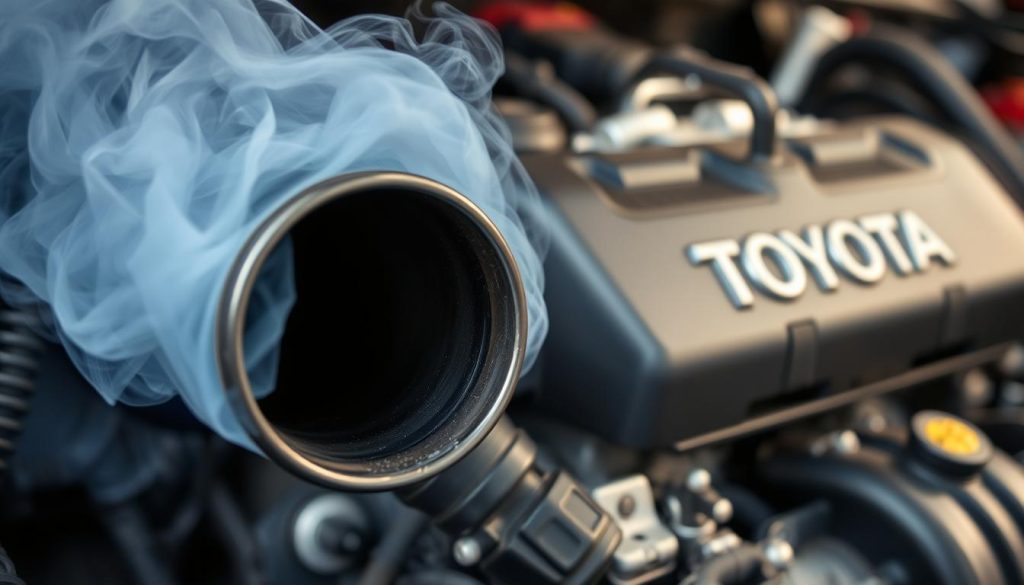
Knowing why Toyota engines make blue smoke is key to fixing them. By finding the cause, like worn parts or oil issues, owners can fix the problem. This stops further damage and keeps the engine running well.
Black Smoke Causes in Toyota Vehicles
Black smoke from your Toyota is a warning sign. It means your engine is burning too much fuel. This can hurt your fuel efficiency, increase emissions, and damage your engine.
Rich Fuel Mixture Problems
Black smoke usually comes from a rich fuel mixture. This happens when there’s too much fuel in the engine. Faulty fuel injectors, a clogged air filter, or ECU problems can cause this imbalance.
Clogged Air Filter Effects
A dirty air filter can harm your Toyota’s engine. It blocks airflow, making the fuel mixture too rich. This leads to black smoke. Always check and replace your air filter regularly.
Malfunctioning Fuel Injectors
Fuel injectors are key for the right fuel mix. If they fail, they can leak or stick, causing black smoke. It’s important to clean or replace faulty injectors.
Mass Air Flow Sensor Issues
The MAF sensor checks air intake and helps the ECU mix fuel and air right. A bad MAF sensor can make the engine run too rich, causing black smoke. Fixing or replacing a faulty MAF sensor is vital for your engine’s health.
To fix black smoke from your Toyota, find and fix the root cause. It could be a rich fuel mix, a clogged air filter, bad fuel injectors, or MAF sensor problems. Quick repairs can keep your car running well and cut down on emissions.
Diagnosing Toyota Smoking Exhaust Problems
Smoking exhaust in Toyotas can come from many sources. To find the exact problem, you need a careful approach. It’s important to know the color and type of smoke to figure out what’s wrong.
Visual Inspection Techniques
Start by visually checking the exhaust pipe. Look for leaks or damage. Also, check for unusual smoke colors or too much smoke. White smoke might mean coolant is leaking, while blue smoke could be oil consumption. Black smoke usually means too much fuel.
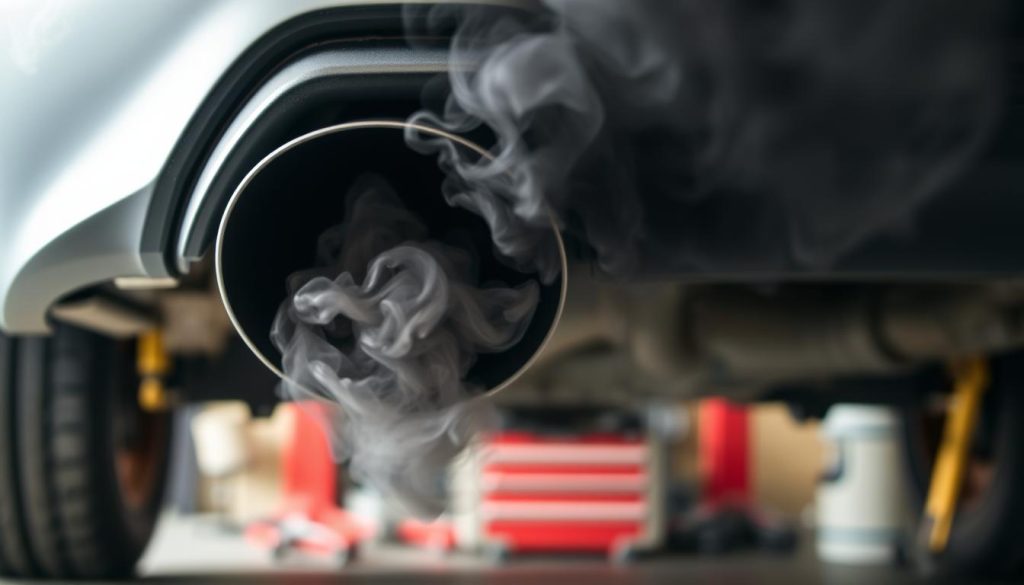
Using OBD-II Scanners for Diagnosis
An OBD-II scanner is a great tool for finding smoking exhaust problems. It shows error codes that point to issues like bad sensors or fuel problems. Just plug it into your Toyota’s OBD-II port to get codes that help you find the problem.
Compression and Leak-Down Testing
For deeper checks, try compression and leak-down tests. These tests find engine problems like worn parts or leaks. A compression test checks the engine’s pressure, and a leak-down test finds where pressure leaks out.
Smoke Color Analysis Guide
- White/Gray Smoke: Usually means coolant is getting into the engine.
- Blue/Gray Smoke: Shows oil is being burned, often due to worn parts.
- Black Smoke: Means there’s too much fuel, possibly from a bad fuel injector or clogged air filter.
Using these methods, Toyota owners can find and fix smoking exhaust problems. This keeps their car running well and eco-friendly.
DIY Solutions for White Smoke Issues
White smoke from your Toyota’s exhaust can be scary. But, there are DIY fixes you can try. First, understand the possible causes and how to fix them.
Head Gasket Replacement Steps
A blown head gasket often causes white smoke. Replacing it requires several steps:
- Step 1: Drain the coolant and remove the intake manifold.
- Step 2: Take out the cylinder head and check for damage.
- Step 3: Put in a new head gasket and put everything back together in reverse.
For a detailed guide, check your Toyota’s repair manual. It’s important to follow the manufacturer’s instructions to avoid more damage.
Checking and Fixing Coolant Leaks
Coolant leaks can also lead to white smoke. To find and fix leaks:
- Look for signs of leakage in the cooling system.
- Use a pressure tester to find the exact leak spot.
- Replace any damaged parts, like hoses or the radiator cap, as needed.
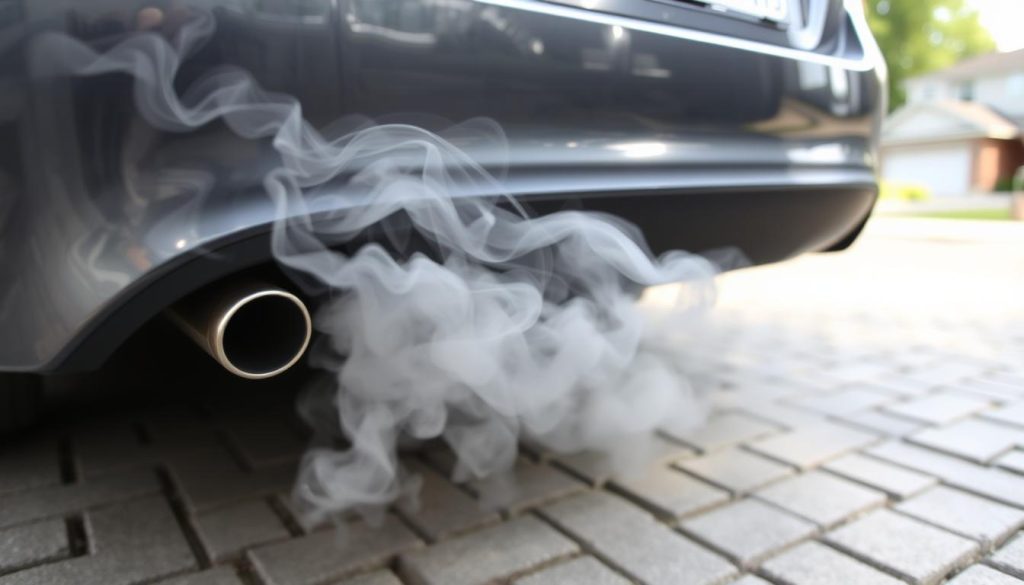
Pressure Testing the Cooling System
Pressure testing is a great tool for finding leaks and weaknesses in the cooling system:
- Connect a pressure tester to the radiator.
- Pump it up to the right pressure.
- Listen for hissing or watch the pressure gauge for drops.
When Professional Help is Necessary
While many white smoke problems can be fixed DIY, some need a pro. If you’re not sure or feel uneasy about repairs, get a certified mechanic. They can give a precise diagnosis and do complex repairs, like engine rebuilding or replacement, if needed.
By trying these DIY fixes and knowing when to get professional help, you can fix white smoke issues in your Toyota. This ensures a smoother and more efficient repair process.
Fixing Blue Smoke Problems in Toyota Vehicles
Blue smoke from a Toyota’s exhaust means oil is leaking into the engine. This can hurt the engine’s performance and cause damage over time. It’s important to fix this problem quickly.
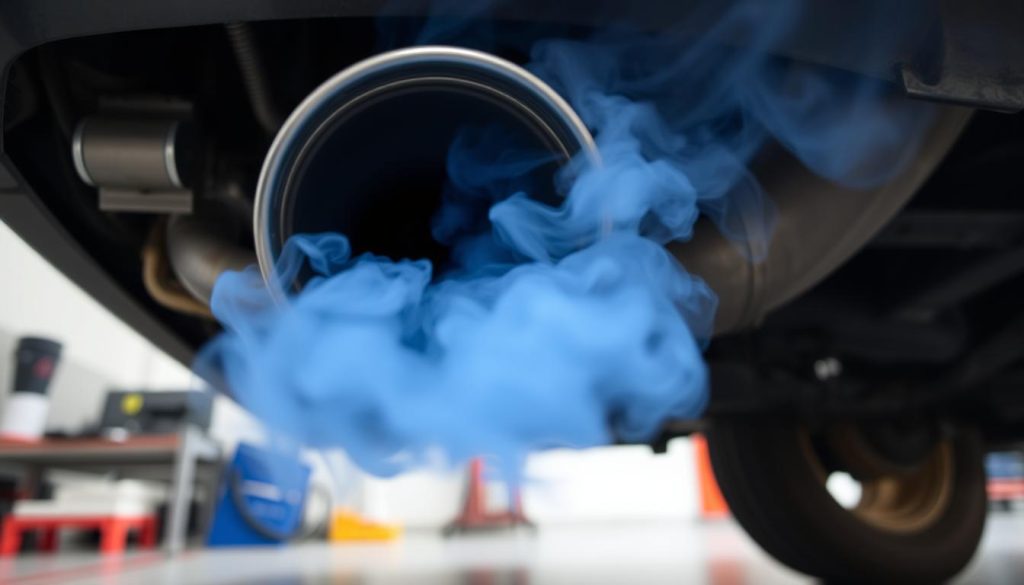
Valve Seal Replacement Process
Worn or damaged valve seals often cause blue smoke. Replacing them involves a few steps:
- Removing the valve cover to access the valve seals
- Using a valve seal replacement tool to remove the old seals
- Installing new valve seals and reassembling the engine components
This job needs care and the right tools to seal properly and avoid leaks.
Piston Ring Repair Considerations
Damaged piston rings can also let oil into the engine, causing blue smoke. Fixing or replacing these rings is a detailed task that may include:
- Disassembling the engine to reach the pistons
- Checking the piston rings and cylinder walls for damage
- Replacing the piston rings and possibly honing the cylinder walls
It’s important to check how bad the damage is to decide the best fix.
Oil Consumption Monitoring Methods
After fixing blue smoke, it’s key to watch oil consumption. This helps make sure the problem doesn’t come back. Ways to do this include:
- Regularly checking oil levels
- Using oil consumption gauges for more precise monitoring
- Keeping a log of oil usage over time
Engine Rebuild Evaluation
In very bad cases, you might need to rebuild the engine. This means checking the engine’s parts, like valves and pistons, thoroughly. A rebuild is expensive but might be the best fix for ongoing blue smoke.
By fixing the blue smoke problem and doing the needed repairs, Toyota owners can get their car running well again. This prevents more damage.
Resolving Black Smoke from Toyota Exhaust
To fix black smoke from your Toyota’s exhaust, you need to find and fix the main problem. Black smoke usually means there’s too much fuel or other fuel system issues.

Air Filter Replacement Procedure
A dirty air filter can mess up the air-fuel mix, causing black smoke. Replacing it is easy and can make your Toyota run better.
- Find the air filter housing in the engine area.
- Open it and take out the old air filter.
- Clean the housing if it’s dirty.
- Put in a new air filter and make sure it fits right.
Fuel System Cleaning Techniques
Build-ups in the fuel system can make fuel burn poorly, leading to black smoke. Cleaning the fuel system regularly keeps your engine running well.
Fuel injector cleaning can be done with special kits or by adding cleaners to your fuel.
Oxygen Sensor Testing and Replacement
A bad oxygen sensor can send wrong info to the engine computer, causing too much fuel. You can test it with an OBD-II scanner to find trouble codes.
Fuel Injector Maintenance
Keeping fuel injectors clean is key to avoiding black smoke. Use fuel injector cleaners and keep the fuel system clean of debris.
By taking these steps, Toyota owners can find and fix black smoke problems. This improves their car’s performance and cuts down on emissions.
Toyota Smoking Exhaust: Model-Specific Solutions
When dealing with Toyota smoking exhaust, knowing your car’s model is key. Each Toyota model has its own smoke problems. So, finding the right fix for your car is important.
Camry and Avalon Common Problems
Camry and Avalon owners might see white smoke. This usually means coolant is leaking into the engine. Look for coolant leaks and check the coolant level often.
Corolla and Prius Exhaust Smoke Issues
Corolla and Prius drivers might see blue or gray smoke. This usually means the car is burning oil. Worn seals or damaged rings are common causes. Keeping up with oil changes helps.
Tacoma, Tundra, and 4Runner Considerations
Tacoma, Tundra, and 4Runner owners might see black smoke. This is often from too much fuel. A bad oxygen sensor or a clogged air filter can cause this. Regular maintenance helps fix these problems.
RAV4, Highlander, and Sienna Troubleshooting
RAV4, Highlander, and Sienna owners should check for faulty fuel injectors or clogged air filters. A malfunctioning PCV valve can also cause smoke. An OBD-II scanner can find these issues.
Knowing the specific problems of your Toyota model helps fix Toyota exhaust smoke troubleshooting issues. This ensures your car runs well and efficiently.
Professional Repair Options and Costs
Toyota owners with exhaust smoke problems have several repair options. The choice depends on cost, warranty, and the problem’s nature.
Dealership vs. Independent Shop Comparison
Owners can pick between dealership services and independent shops for exhaust repairs. Dealerships use genuine parts and have specialized knowledge but cost more. Independent shops might be cheaper but vary in expertise and part quality.
| Service Provider | Cost | Parts Quality | Warranty |
|---|---|---|---|
| Dealership | Higher | Genuine | Manufacturer’s Warranty |
| Independent Shop | Variable | Aftermarket/Genuine | Shop Warranty |
Average Repair Costs by Problem Type
Repair costs for a smoking Toyota exhaust vary by problem. Fixing a blown head gasket can cost $1,000 to $2,000. Replacing a faulty oxygen sensor might cost $200 to $500.
Insurance and Warranty Considerations
Check if your Toyota is under warranty or if insurance covers repairs. Some exhaust system issues might be covered by the manufacturer’s warranty or powertrain warranty.
Finding a Reliable Toyota Specialist
When looking for a Toyota repair specialist, find certified technicians with Toyota experience. Look for online reviews, ask for referrals, and make sure they use genuine or high-quality parts.
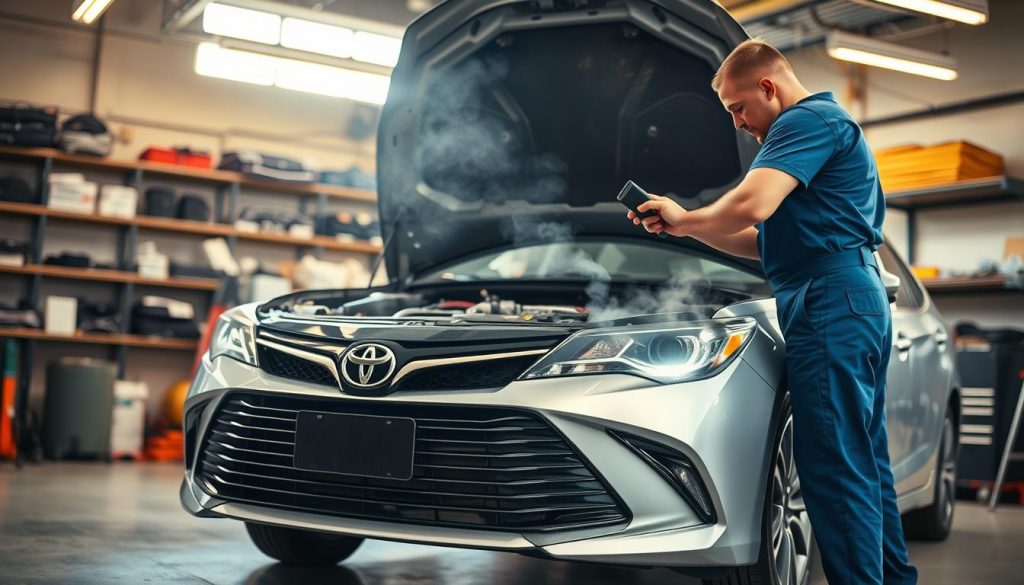
Preventive Maintenance to Avoid Exhaust Smoke
To keep your Toyota running smoothly and smoke-free, preventive maintenance is key. Regular maintenance ensures your vehicle runs well. It also helps spot problems early on.
Optimal Oil Change Schedules and Types
Following the right oil change schedule is a simple yet effective way to prevent exhaust smoke. Using the correct oil type is also vital. It lubricates the engine and prevents wear and tear that could cause smoke.
Synthetic oil is a good choice for many Toyota models. It offers better lubrication and can handle high temperatures well.
Cooling System Maintenance Routine
The cooling system is important for preventing overheating. Overheating can damage your vehicle and cause exhaust smoke. It’s important to regularly check the coolant level and inspect hoses for leaks.
Also, make sure the radiator is clean and working right. These steps help keep the cooling system in good shape.
Fuel System Care and Quality
Maintaining the fuel system is also key. Using high-quality fuel is important. It helps prevent issues that might cause black smoke from the exhaust.
Periodically cleaning the fuel injectors is also a good idea. This helps keep the fuel system running smoothly.
Regular Inspection Checklist
- Check oil level and condition regularly
- Inspect coolant level and look for leaks
- Ensure air filter is clean and replace as needed
- Have the fuel system cleaned periodically

Environmental and Legal Implications
It’s important for Toyota owners to know about the environmental and legal sides of smoking exhaust. This issue affects how well your car runs and has bigger effects too.
Emissions Testing Requirements
Toyota cars must pass emissions tests to meet environmental rules. If they fail, you could face fines and have to fix your car. Keeping up with maintenance helps avoid these problems.
State and Federal Regulations
State and federal laws control car emissions. Toyota owners must follow these laws to stay out of trouble. This means sticking to emissions standards and getting your car checked often.
Environmental Impact of Exhaust Smoke
Smoke from Toyota cars can harm the environment and people’s health. It adds to air pollution. Cutting down on emissions is key to lessening this harm.
Avoiding Emissions Violations
To dodge emissions problems, Toyota owners should:
- Keep their car’s engine and emissions system in good shape.
- Fix any issues that make the car smoke right away.
- Make sure their car passes emissions tests.
By doing these things, owners can lessen their car’s environmental impact and follow the law.

When to Consider Engine Rebuilding or Replacement
Deciding whether to rebuild or replace a Toyota engine is a big choice. It’s important when your car starts smoking exhaust. This choice depends on how bad the damage is and your car’s overall health.
Cost-Benefit Analysis Framework
Choosing between rebuilding and replacing your engine needs careful thought. You should:
- Compare the cost of fixing it versus buying a new or rebuilt engine
- Look at your car’s age, mileage, and condition
- Think about the chance of future problems with a rebuilt or new engine
Signs That Major Work is Needed
Some signs show you need big engine work, like:
- Smoking exhaust that won’t stop, even after fixing it
- Big drops in power or performance
- Strange noises coming from the engine
Rebuilt vs. New Engine Options
Toyota owners face a choice between rebuilt and new engines. A rebuilt engine might save money but might not last as long as a new one.
Vehicle Value Considerations
Think about your car’s value when deciding to rebuild or replace the engine. For older cars, rebuilding might be cheaper. But for newer cars, replacing the engine might be better.
Tools and Products for Smoke Diagnosis and Repair
Having the right tools and products is key for fixing smoking exhaust issues in Toyotas. Owners need the right tools to diagnose and repair these problems.
Essential DIY Diagnostic Tools
DIY fans need the right tools. An OBD-II scanner is vital for finding engine trouble codes. A compression test kit also helps find internal engine issues that cause smoke.
Recommended Products and Additives
There are products that can help fix smoking exhaust issues. Fuel system cleaners remove deposits that harm engine performance. For oil consumption problems, high-mileage oil is helpful.
Professional-Grade Equipment
For tough diagnoses, you need professional tools. This includes smoke machines for finding leaks and exhaust gas analyzers for checking emissions.
Safety Equipment Requirements
When using tools, safety is a top priority. You’ll need gloves, safety glasses, and a face mask to protect yourself.
Conclusion: Maintaining a Smoke-Free Toyota
To keep your Toyota smoke-free, you need to pay close attention and do regular maintenance. Knowing why your car might smoke and fixing problems quickly helps avoid big repairs. This way, you can catch small issues before they get worse.
Regular checks and maintenance are key. This includes changing oil on time, keeping the cooling system in good shape, and taking care of the fuel system. Also, fixing or replacing worn-out parts helps keep your car running smoothly without smoke.
By following the tips in this article, Toyota owners can drive in a cleaner, more efficient way. Being proactive with your car’s maintenance means less chance of expensive repairs later. This helps keep your car running well and reduces the risk of Toyota smoking exhaust problems.
FAQ
What are the common causes of white smoke from a Toyota’s exhaust?
White smoke often comes from coolant system problems. This includes a leaking head gasket, cracked cylinder head, or engine block. Coolant leaking into the engine can cause this smoke.
How can I diagnose the cause of blue smoke in my Toyota’s exhaust?
Blue smoke means oil is burning. Look for worn valve seals, damaged piston rings, or oil leaks. A compression test can help find the problem.
What does black smoke from my Toyota’s exhaust mean?
Black smoke means there’s too much fuel. Check for a clogged air filter, faulty fuel injectors, or a mass air flow sensor issue.
Can I fix a smoking exhaust issue on my own, or do I need professional help?
Simple fixes like replacing a head gasket or air filter are DIY-friendly. But, complex problems need a pro. If unsure, get professional help.
How can I prevent exhaust smoke issues in my Toyota?
Regular maintenance is key. Keep up with oil changes, cooling system checks, and fuel system care. This helps avoid smoke issues.
Are there any model-specific solutions for Toyota exhaust smoke issues?
Yes, each Toyota model has its own issues. Some are more prone to head gasket leaks or oil problems. Know your model’s common problems to tackle them.
What are the environmental implications of smoking exhaust, and how can I avoid emissions violations?
Smoking exhaust harms the air and can fail emissions tests. Fix the smoke issue and keep your vehicle well-maintained. Know the emissions laws in your area.
When should I consider rebuilding or replacing my Toyota’s engine due to smoking exhaust?
If the problem is serious or won’t go away, rebuilding or replacing the engine might be best. Think about your vehicle’s value, repair costs, and damage extent.
